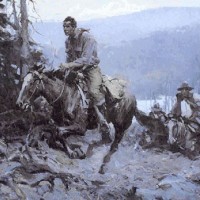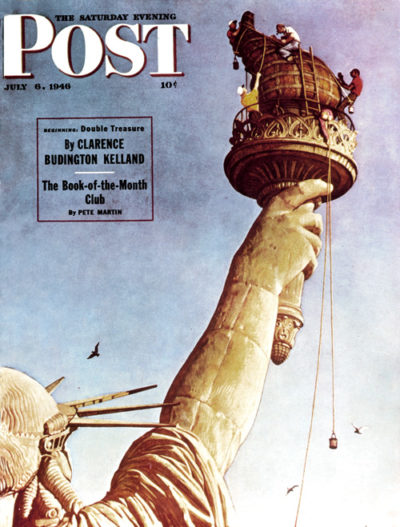Ford, Nixon, and the Controversies behind Presidential Pardons
On September 8, 1974, in one of the most controversial shows of presidential clemency, Gerald Ford pardoned “all offenses against the United States” that Richard Nixon may have committed between January 20, 1969 and August 9, 1974.
According to Alexander Hamilton, the Constitution gives the president the power to pardon criminals in order “to restore tranquility to the commonwealth” in politically divisive cases. But sometimes, instead of tranquility, pardons further divided the country and even destroyed presidents’ careers. Although few pardons are without controversy, some have created more waves than others.
Here’s a look at some of the more memorable pardons by our nation’s presidents.
George Washington and the Whiskey Rebellion
George Washington granted the first presidential pardon when he spared the lives of two men who’d been sentenced to hang for their part in Pennsylvania’s Whiskey Rebellion. Washington had sensed the rebellion was dying away and didn’t want to revive the cause by hanging men for treason. Hamilton didn’t approve; he wanted to make an example to other tax resisters. But pardoning the men shifted the country’s attentions away from the fading rebellion and helped defuse lingering anti-government feelings.
Andrew Johnson and the Confederacy
Andrew Johnson had the same idea in 1865, but not the same results. After the Civil War ended, he sought to reunite the country by pardoning thousands of former office-holders of the Confederacy. He believed he was carrying out the lenient attitude that President Lincoln would have wanted. Within a year of the war’s end, Johnson had granted pardons to more than 6,000 former officials of the Confederacy.
Members of the Republican Party were furious with Johnson. They believed he was giving power back to the rebels and traitors who’d started the war. Some senators thought Johnson was guilty of treason for aiding the Union’s former enemies. The Republicans split between the pro- and anti-Johnson factions. In 1868, Johnson’s opponents began impeachment hearings against him. Johnson escaped impeachment by one vote, but the Republicans, and the nation, remained divided between pro- and anti-leniency factions for years.
Harry Truman and the Conscientious Objectors
During World War II, over 15,000 Americans objected to participating in the war and refused to serve in the military. When the war ended, President Truman asked a board to review these cases to see who truly qualified for conscientious-objector status. The board found 1,500 objectors who had legitimate religious convictions barring them from service. Truman pardoned these men on December 23, 1947.
Amnesty activists pleaded with Truman to pardon the others, but he refused. Believing he’d released all honest draft resisters, he regarded the remaining conscientious objectors as “just plain cowards or shirkers.”
Jimmy Carter and the Draft Dodgers
In 1977, President Jimmy Carter was considering the fate of American men who’d refused to serve in the Vietnam War. The war had ended, but thousands who had evaded the draft were still in prison. Carter knew Americans were sharply divided over the war. He thought pardoning the draft dodgers would help resolve the divisions and move the country forward.
On January 21, 1977, he extended amnesty to all men who’d failed to register for the draft or who fled the country to avoid conscription. This included more than 50,000 American men who’d fled to Canada. The amnesty did not extend to over 500,000 men who were imprisoned for going AWOL while in uniform.
The pardon was welcomed by the families of draft dodgers, but veterans who’d served in Vietnam were infuriated. Resentment among Americans who’d supported the war only deepened. The pardon helped erode Carter’s support and probably contributed to his failed re-election bid.
Ford and Nixon
One of the most controversial presidential pardons was Gerald Ford’s pardoning of Richard Nixon. Ford must have known he’d lose some of the general support he’d enjoyed when he took over the White House after Nixon left. But he’d seen the country preoccupied by the Watergate scandal for over a year, and he knew a lengthy, public trial of Nixon, which would consume at least another year, would further divide pro- and anti-Nixon camps and distract the nation from pressing economic and international issues.
Ford was ready to move on, but the country wasn’t. Though praised by legislators in both parties, he was criticized by many Americans who wanted to see justice meted out to Nixon. A Gallup poll that month showed most Americans disapproved of the pardon. Instead of restoring tranquility to the nation, as he’d hoped, Ford had raised the Watergate issue to even greater prominence. The unpopularity of this action probably cost Ford the presidential election in 1978.
Pardons and Politics
Since then, critics have seen political motives in presidential pardons. Some considered President George H.W. Bush’s pardoning of six participants in the Iran-Contra Affair as a convenient way of protecting himself from having to testify on the affair before Congress. Some of President Clinton’s pardons were viewed by critics as efforts to protect major donors or buy votes among minority groups. In 2007, President George W. Bush commuted the prison sentence of vice-presidential advisor Lewis Libby, who’d been convicted for obstruction of justice and perjury. Bush’s action was so widely considered a cover-up for the president’s involvement that the House Judiciary Committee investigated whether pardons were being used for political gain.
It’s impossible for a president not to gain political advantages by extending a pardon. But the chief motive in pardoning should always be what Hamilton described in 1787 — restoring tranquility to the commonwealth — even if some Americans aren’t ready to forgive.
Featured image: Gerald R. Ford (White House Archives, Gerald R. Ford Library)
Obama’s Rockwell
“Celebrate America—Past, Present, and Future.” That’s the tagline of our country’s oldest magazine. The Saturday Evening Post’s legendary archives date back to 1821, but the magazine is better known for its ever-popular cover art and inside illustrations. Artists range from the iconic Norman Rockwell to the lesser-known Western depictions of W.H.D. Koerner.
It’s only fitting, then, that when it comes to selecting art that both reflects our nation’s values and presidents’ personal tastes, the highly revered paintings from The Saturday Evening Post are an appropriate fit, with images that speak to the everyday American spirit.

From his governor’s office in Texas, former President George W. Bush brought to the Oval Office a favorite painting of his: a Western scene called A Charge to Keep by W.H.D Koerner. The illustration first appeared in The Saturday Evening Post in 1916 to depict a short story called “The Slipper Tongue.”
With A Charge to Keep back home in Texas, the Obamas, along with their appointed interior designer Michael Smith, gave the Oval Office a subtle makeover, replacing the cowboyesque décor (with the exception of artist Frederic Remington’s sculpture The Bronco Buster) with a more traditional touch, while embracing such classics as the Norman Rockwell painting, the iconic Working on the Statue of Liberty, which appeared on the cover of the Post in July 1946.

The original work of art was previously owned by famed film director Steven Spielberg—an avid Rockwell collector. In 1994 Spielberg donated the painting to the White House where it has proudly hung for Presidents Clinton, Bush, and Obama, according to Jeremy Clowe, manager of media services for the Norman Rockwell Museum. “An additional series of Rockwell works—appropriately titled So You Want to See The President (The Saturday Evening Post story illustration, November 13, 1943)—are also on loan to the White House, and on view in the building’s West Wing,” says Clowe.
The history of the Post is deeply rooted in American culture and will not only continue to find a home in the heart of America, but in the hearts of Americans. Today’s Post readers turn to the magazine for a dose of artistic nostalgia, an update on current cultural trends, and a forecast for medical breakthroughs and emerging technology of days to come, as the Post continues to “Celebrate America—Past, Present, and Future.”